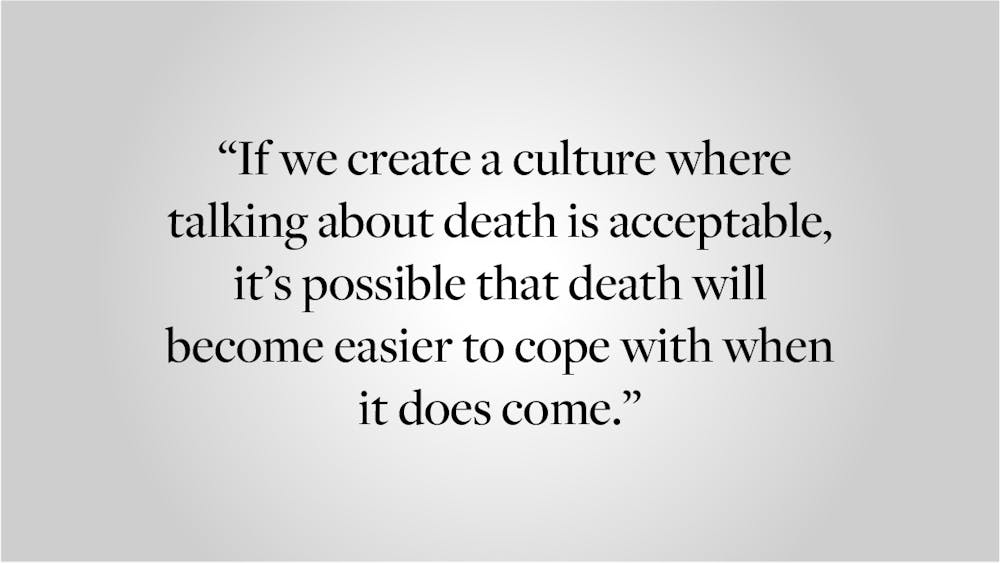My mom only told me that she had been diagnosed with ovarian cancer after she was officially cancer-free. I didn’t know what to say. She explained that she’d been getting treatment for the past six months, but she chose to keep it from my sister and me. When my sister asked why we weren’t told earlier, she explained that she didn’t want to stress us out. For months afterward, I wondered what would have happened if the treatment had not worked. How long would my parents have waited to tell us that she might die?
Death is difficult to talk about, especially when your loved ones are immediately threatened by it. However, in the United States, our discomfort around death has festered into a taboo. Death is inevitable, yet we refuse to contend with it in a realistic way. This pervasive avoidance stigmatizes the elderly and dying and results in a lower quality of life for those who are close to death and their loved ones.
Death’s stigma is very real in the United States. Research has indicated that those who don’t encounter death directly harbor negative feelings toward the dying. This stigma manifests as a collective reticence to discuss death in an honest way, which makes it challenging to accept when encountering it in real life. This cultural resistance to acknowledging the inevitability of death leads to insufficient research and interventions that would ease the burdensome end-of-life process. This results in poor-quality care for patients in their last months of life, astronomical financial expenses and psychological trauma in caregivers long after the loved one has passed.
Death stigma also manifests as the mass medicalization of health care in the United States. This has created a rescue fantasy that insists upon trying every possible treatment to prolong life, even if an individual’s passing is unavoidable. Continuously delaying death at all costs does not always improve a patient’s well-being. By framing death as something that can be defeated, we implicitly see dying as a failure. From a young age, we learn to blame the individual for dying instead of accepting death for what it is — a natural conclusion to life. This problem is more important than ever during the COVID-19 pandemic. Grieving families bear the burden of the cultural stigma toward death in addition to shame from a COVID-related death.
Collective stigmatization of death not only worsens end-of-life care, but it can also further prevent societal acceptance of death. Medicalization has been implicated as a major source of negative feeling towards the dying. In many modern medical centers, the power disparity between doctors and patients risks reducing patients to their illnesses, which can be solved. This results in the dissociation of illness from the inevitability of death. Furthermore, by socially isolating patients in medical facilities, we reduce civilian contact with the dying, making death feel unfamiliar and thus abnormal. As a result, our society avoids both the subject of death and interacting with the dying.
Our current end-of-life care practices often disregard the emotional and physical needs of the dying. However, if we restructure end-of-life care around the wishes of patients and their families, quality of life could improve significantly.
By acknowledging the humanity of death at an institutional level, we can make death easier to accept on a personal level. Discussing death openly has been shown to reduce the stress of dying individuals and their caregivers. If we create a culture where talking about death is acceptable, it’s possible that death will become easier to cope with when it does come.
If we want to tackle our cultural stigma around death, the best solution is to be realistic. Other cultures have shown that it is possible to approach the topic of death in a practical way. For example, Swedish death cleaning is a practice where elderly individuals declutter their living areas to the bare essentials. The goal is to reduce the items their loved ones must sort through after they pass, thus relieving undue emotional burden.
Swedish death cleaning is much more than an organizational system — it facilitates self-reflection which can be therapeutic for those close to death. As psychotherapist Amy Morin said, “Getting rid of items serves as a reminder that things don’t last forever, including us.” However, practices such as Swedish death cleaning cannot become commonplace in America until we can accept the idea of dying in the first place, and that starts with a conversation.
There was a time when I felt frustrated at my mother for not telling me about her cancer diagnosis. I felt that she had shut me out and had not given me the opportunity to support her. But I recently realized that it wasn’t about me — she felt ashamed because dying is viewed as a burden on others. I wish my mom had felt comfortable telling us about her cancer while she was still receiving treatment, but neither of us knew how to broach the subject. Death is challenging to talk about, but going forward, I want to have honest conversations with my family to resist the stigma around death in our small way.
Megan Slusarewicz ’23 can be reached at megan_slusarewicz@brown.edu. Please send responses to this opinion to letters@browndailyherald.com and other op-eds to opinions@browndailyherald.com.





